Analyzing In-app Overview
How to analyze the collective impact of all your In-app campaigns to gain valuable insights into user-channel interactions
Once you have launched a few In-app campaigns through the channel or journeys, you will be able to analyze their collective impact on user engagement, conversions, and revenue through In-app Overview.
What Kind of Data is Shown Here?You will see cumulative stats based on user-campaign interactions that occur within the selected time frame.
How to Access
As shown below, this section can be accessed from the central hub of In-app by selecting Overview from the navigation bar.
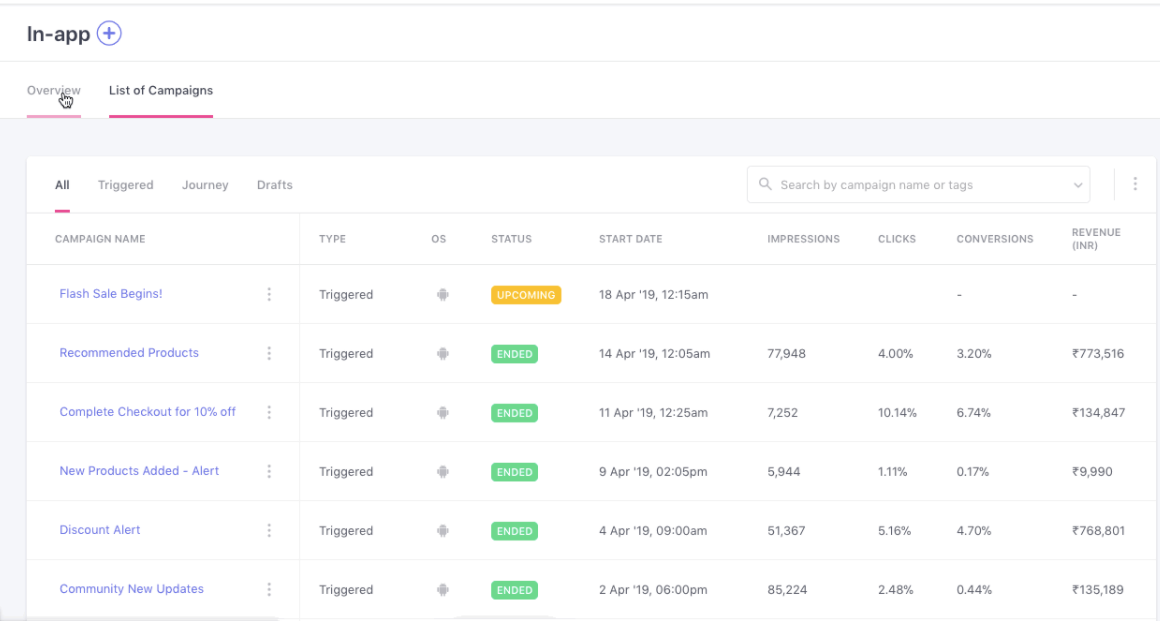
Click to enlarge
So without much ado, let's dig in!
Define the Time Frame of Analysis
By default, In-app Overview shows you the overall impact of all the In-app campaigns for the Last 7 days against key performance indicators like Impressions, Conversions, Revenue, Deliveries, Failures and so on.

Click to enlarge
As shown above, using the filter placed on the top right, you can choose to analyze the channel's performance for the following durations:
- Yesterday
- Last 7 Days
- Last 30 Days
How to Analyze
Now, let's show you how you can analyze In-app Overview to gain valuable insights into the channel's impact on user engagement, conversions, and revenue.
Get all this data in your inbox!You can analyze the collective impact of all In-app campaigns by scheduling reports for your entire team! Head over to Settings> Scheduled Reports in your dashboard to set it up.
Overview
This section provides a comprehensive overview of the channel's performance against broad metrics like Channel Reachability, New Users added, Users Engaged, and Total Revenue generated.

Click to enlarge
Let's go over each card:
Reachability
Reachability is a measure of whether or not a user can be reached through the various channels of engagement. Thus, this card indicates the number of users that can be engaged via In-app Notifications, at present. The number is further broken down by iOS and Android, indicating your users' device preferences.
- Reachability Percentage: As highlighted in the visual above, the In-app reachability of your entire user base is also indicated as a percentage value, helping you gauge the viability of leveraging this channel to engage all your users.
Please Note
Channel reachability is calculated over the entire lifetime of your users and is updated daily to factor in the reachability of new users and the changing channel preferences of existing users. For the same reason, Reachability cannot be analyzed for a particular time frame.
A sum of the reachability numbers shown against each OS may exceed the total. This is because users who are reachable on both Android and iOS are counted towards the _Overall Reachability _only once, but are added towards the reachability numbers of both OS.
New Users
All users that have installed your app within the selected time frame, are considered towards the total number of New Users.
This number is bifurcated into iOS and Android, indicating your users' device preferences.
Users Engaged
Indicates unique users that have received at least one In-app campaign within the selected time frame. If a user receives multiple In-app Notifications, then they will be counted towards the total number of Users Engaged only once to avoid double counting.
Revenue
Indicates a sum of the revenue generated by the Total Conversions tracked for all the In-app campaigns within the selected time frame.
Revenue numbers are always shown in the currency selected by you while setting up Revenue Mapping.
Please NoteIf you have not specified a Conversion Event for a campaign while creating it, or if the specified Conversion Event is not mapped as a Revenue Event, then Revenue will not be tracked for it. Detailed read on how Revenue Tracking works.
Control Group report
This section indicates overall campaign performance v/s control groups for the campaigns where either Universal or Custom control groups have been added.
Based on the 'Conversions' in your Target Group (users who were not part of the CG) and the selected Control Group, you will be able to see the overall Uplift (or downlift) that your campaigns are having. Conversion Uplift is calculated using this formula:
Conversion Uplift =[(Unique Conversion Rate of TG/ Unique Conversion Rate of CG) x 100] - 100
In addition to conversion uplift, you can also calculate the revenue increment through Revenue and Order Uplift.
Formula to calculate Revenue Uplift :
- CG projected total revenue = CG(Total Revenue / Total Sent Count) X TG Total Sent Count
- Revenue Uplift (absolute value) = [TG Revenue - CG Revenue (Projected to TG Volume)]
- Revenue Uplift %= [TG Revenue / CG Revenue (Projected to TG Volume) X 100] - 100
Formula to calculate Order Uplift
- Order Uplift (absolute value)= (TG Order Rate - CG Order Rate) X TG Total Sent Count
- Order Uplift % = (TG Order Rate / CG Order Rate X 100) - 100
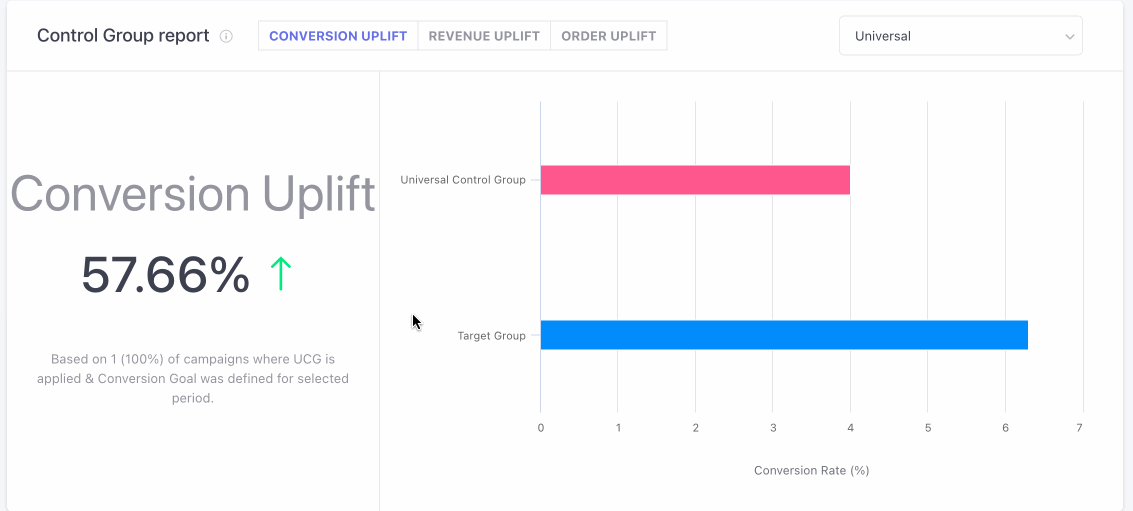
Please Note
Control Group report is Visible only when you have created a Universal Control Group or Custom Control Group. Click here to learn how to create one.
Campaigns in which a conversion event is added and selected control group is attached along are only taken into consideration for this analysis.
Campaign Comparison
The most insightful section of In-app Overview, Campaign Comparison helps you analyze the collective impact of all your campaigns and identify trends of user-channel interactions against key metrics, split by campaign types.
It has been divided into two subsections to facilitate multi-dimensional analysis:

Click to enlarge
By default, Campaign Comparison shows you the overall performance of all In-app campaigns for the selected time frame. You can further customize the data by selecting a campaign type.
Here's how you can go about it:
Select a Campaign Type
As discussed under Campaigns and Its Types, messages sent through the various channels of engagement are called campaigns and can be of the following types: One-Time, Triggered, Recurring and Journey.
However, given the real-time and targeted nature of the channel, you can only send Triggered and Journey campaigns through In-app.
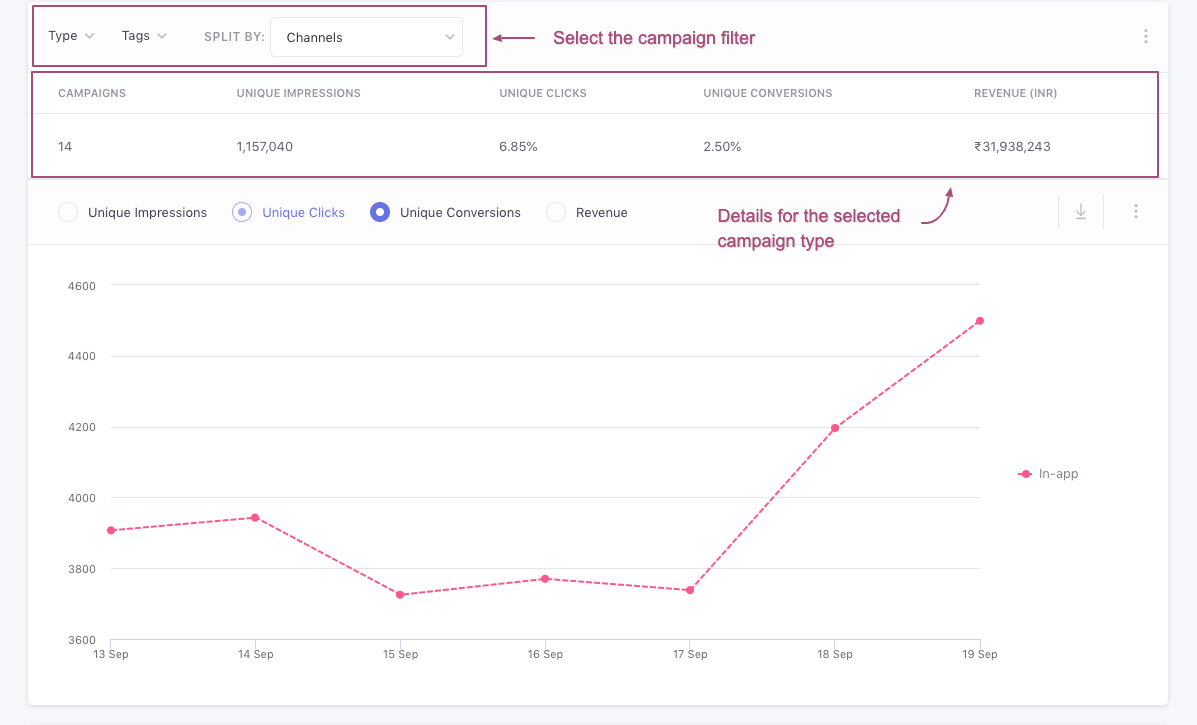
Click to enlarge
Using the navigation bar highlighted above, you can select a campaign type to narrow down the scope of analysis.
The following options can be selected here:
All: The default option selected here, it helps you analyze the channel's performance on the basis of all types of campaigns sent through it.
Triggered: Helps you analyze the channel's performance only on the basis of its triggered campaigns.
Journey: Helps you analyze the channel's performance only on the basis of its journey campaigns.
Now let's get you acquainted with each subsection:
Top Panel
Here you can analyze the performance of In-app as a channel against broad metrics and collect valuable insights.

Click to enlarge
Such insights not only help you gauge ROI but also help determine the viability of engaging users through the channel in the long run.
Let's quickly go over the performance indicator shown here:
Campaigns: Indicates the total number of campaigns sent within the selected time frame, for the chosen campaign type.
Users Engaged: Indicates unique users that received at least one in-app campaign within the selected time frame, for the chosen campaign type.
Impressions: Captured from your user's device, it indicates the number of times users have seen an In-app message within the selected time frame, for the chosen campaign type.
Unique Clicks: Calculated against Impressions, it indicates the percentage of users that have clicked on an In-app campaign within the selected time frame, for the chosen campaign type.
Unique Conversions: Calculated against Impressions, it indicates the percentage of users that have performed the Conversion Event of an In-app campaign within its Conversion Deadline, in the selected time frame, for the chosen campaign type.
Revenue: Indicates a sum of the revenue generated by the Total Conversions tracked for all the In-app campaigns within the selected time frame, for the chosen campaign type. Detailed read on how revenue tracking works.
Related ReadPlease refer to Campaign and Channel Performance Indicators for a comprehensive list of all the metrics tracked for In-app campaigns.
Select a Data Format (Optional)
Using the overflow menu highlighted below, you can choose to analyze Clicks and Conversions as a numerical value (by selecting #), or as a percentage value (by selecting %).

Click to enlarge
Graph
Here you can analyze the correlation between Impressions, Unique Clicks, and Unique Conversions as trend graphs, split by days, for the selected time frame and campaign type.
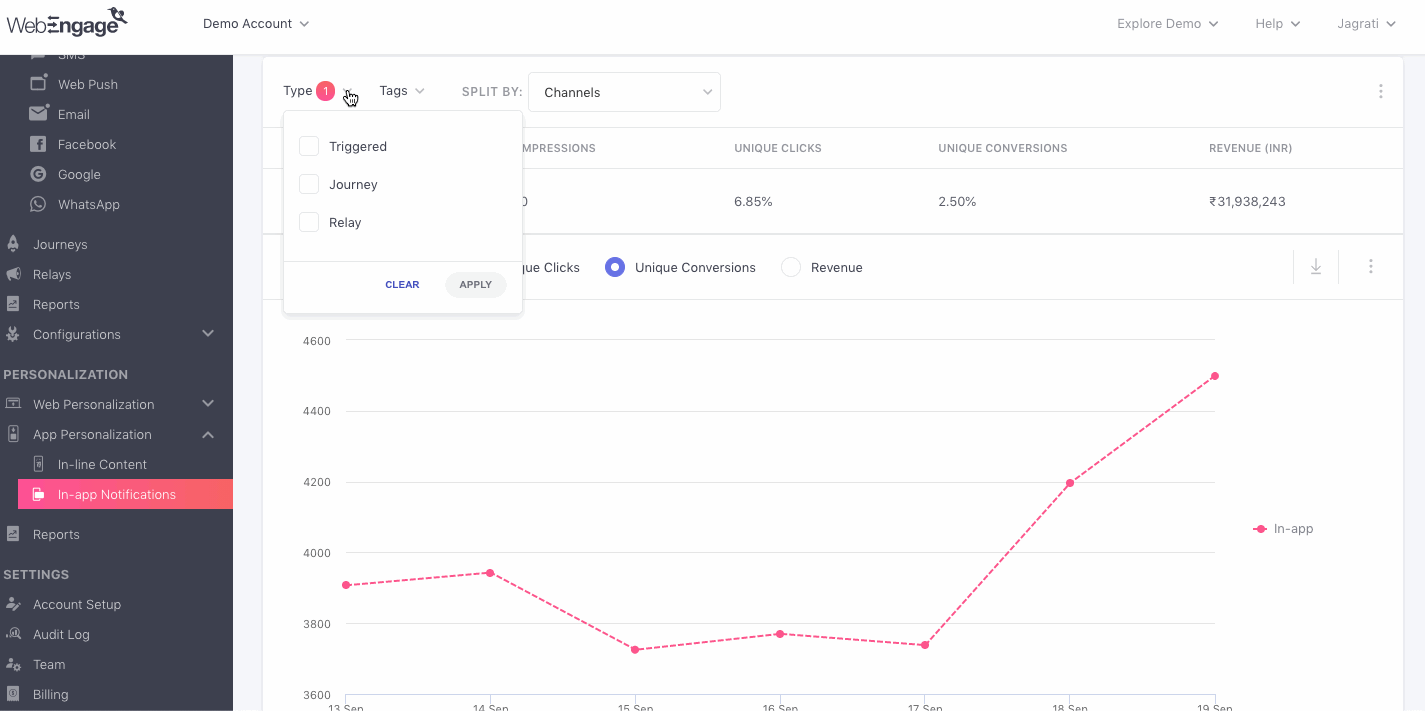
Click to enlarge
Select the Format of Visualization (Optional)
Lastly, while the default format of visualization is a Line Graph, using the overflow menu highlighted below, you can choose to analyze data as a Bar Graph.
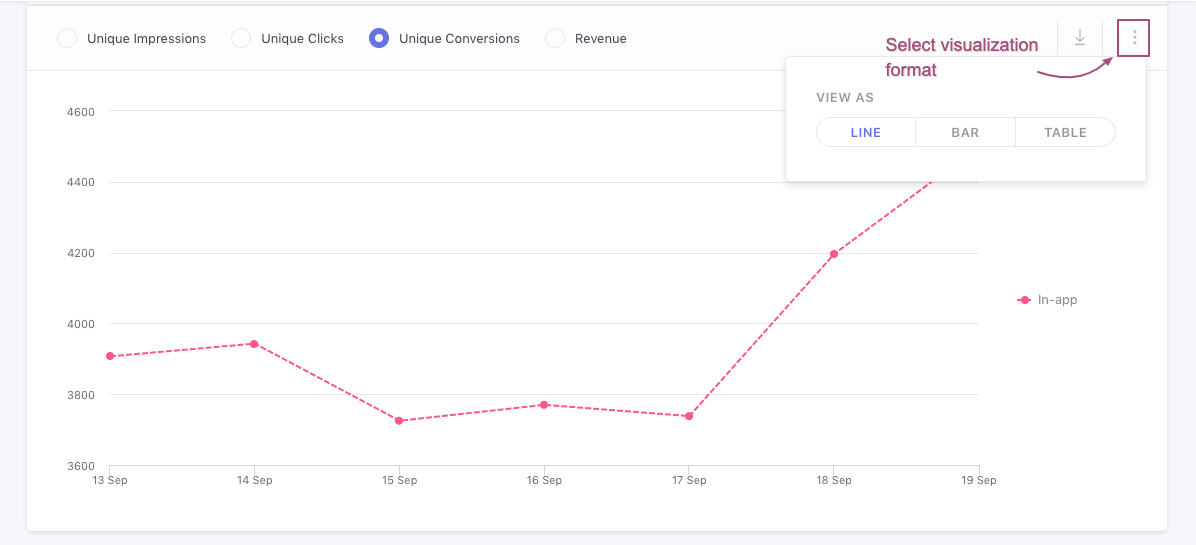
Click to enlarge
Why do I see 'No Data to Display' in this section?The message indicates that campaigns of the selected type do not exist. This usually occurs if:
- The campaigns were deleted
- No campaigns were sent within the selected time frame
- No data was tracked for the selected campaign type within the chosen time frame
For example, let's say that you select Journey as the campaign type and choose to analyze the user-channel interactions that occurred Yesterday.
However, instead of data, you are shown No Data to Display. This means that no data was collected for Journey In-app campaigns within the selected time frame, indicating that the respective journeys have been Paused or Stopped.
Engagement Trends
This section helps you analyze user engagement trends for all In-app Notifications against the most crucial performance indicators - Impressions, Clicks, and Conversions.
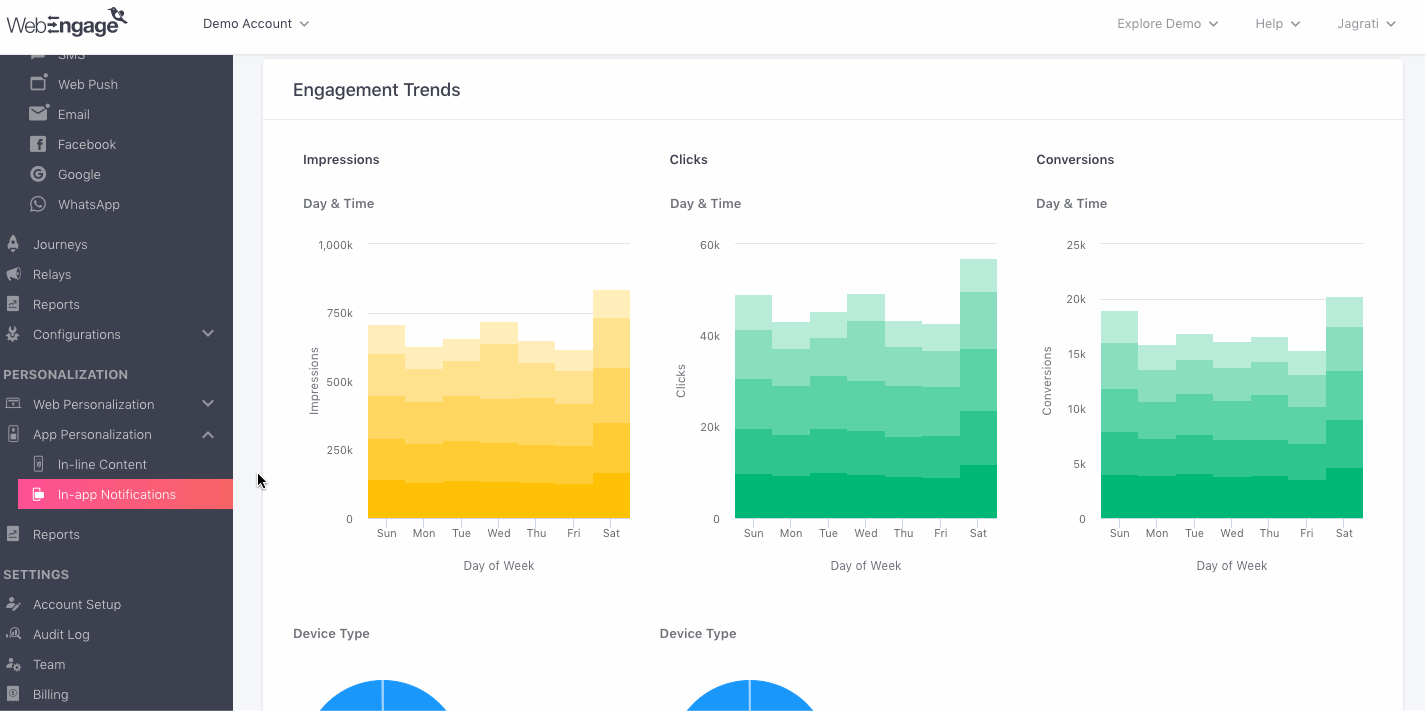
Click to enlarge
Analyzing In-app Engagement TrendsIn the visual above, we have analyzed Impression, Click, and Conversion trends for the Last 30 Days.
It reveals that:
Impressions, Clicks, and Conversions seem to be distributed evenly across various time slots throughout the week - indicating that the time of sending the in-app message has little to no impact on user engagement.
The Impression trends clearly show spikes on Monday and Wednesday - making these ideal days to engage users.
However, Click trends seem to be evenly spread across all days, with a minor spike on Monday. We will need to dig deeper into all the In-app campaigns triggered on a Monday over the last 30 days to better understand this behavior.
Interestingly, Conversion trends show spikes on Sunday and Wednesday.
This indicates that In-app Notifications triggered on a Sunday inherently enjoyed higher conversion rates, compared to the other days.
Wednesday emerges as the best day to engage users with In-app Notifications, given the high Impressions and Conversions recorded on the day.
Lastly, Mobile seems to be the most preferred device for interacting with the channel.
Now, let's get you acquainted with the various metrics shown here:
Impressions Against Days and Time: Indicates Impression trends for each day of the week against the following durations, for the selected time frame:
- 12 am to 4 am
- 4 am to 8 am
- 8 am to 12 pm
- 12 pm to 4 pm
- 4 pm to 8 pm
- 8 pm to 12 am
Impressions Against Device Type: Indicates Impression trends for the selected time frame as per the device (mobile, tablet) on which users received your In-app Notifications.
Clicks Against Days and Time: Indicates Unique Click trends for each day of the week against the following durations, for the selected time frame:
- 12 am to 4 am
- 4 am to 8 am
- 8 am to 12 pm
- 12 pm to 4 pm
- 4 pm to 8 pm
- 8 pm to 12 am
Clicks against Device Type: Indicates Unique Click trends for the selected time frame, as per the devices (mobile, tablet) on which the users received your In-app Notifications.
Conversions Against Days and Time: Indicates Unique Conversion trends for each day of the week against the following durations, for the selected time frame:
- 12 am to 4 am
- 4 am to 8 am
- 8 am to 12 pm
- 12 pm to 4 pm
- 4 pm to 8 pm
- 8 pm to 12 am
Related ReadPlease refer to Campaign and Channel Performance Indicators for a complete list of all the metrics tracked for In-app campaigns.
We hope this gives you a good idea of how you can analyze the collective impact of all your In-app campaigns on user engagement and revenue. Please feel free to drop in a few lines at [email protected] if you have any queries. We're always just an email away!
Updated 2 months ago